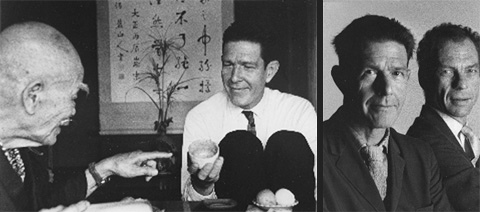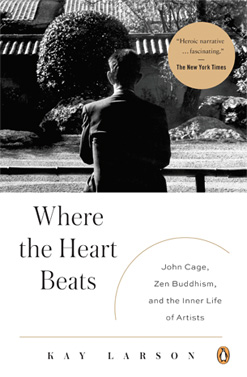I don’t understand why people are
frightened of new ideas. I’m frightened
of the old ones.” — John Cage
Zen saved John Cage from himself. D. T. Suzuki, the great Japanese scholar who introduced Zen to the West, settled in New York in September 1950. Cage sought out Suzuki’s classes, and found release from the self-judgment and fear that shattered him in the 1940s. Zen showed Cage his true nature: peaceful, loving, joyful. His response was immediate: He would put all these soaring insights into his music.
Good music can act as a guide
to good living. — John Cage
Art and life are one reality, Cage knew. He found this thought in the 1920s. Where are the walls? Only in the mind, therefore only illusory. Ever after, Cage sought an art that “doesn’t look as if the frame frames it.” An art that continues “beyond the frame.” Even if this had been the only thought Cage bequeathed to his young artist friends, it would have been enough.

Left: D.T. Suzuki with John Cage. Right: Cage with Merce Cunningham.
Every something is an
echo of nothing. — John Cage
Cage’s revolution was spiritual and musical, aesthetic and intellectual, theoretical and practical. Cage looked west to Asia, and learned a new Way of Being: let go of grasping; be the moment; celebrate eternal mutability; see the emptiness in a grain of sand. The result was 4’33”, Music of Changes, Theatre Piece No. 1, Imaginary Landscape No. 4, Williams Mix — works he wrote after 1950.
Our intention is . . . to wake up to the very life
we’re living, which is so excellent once one
gets one’s mind and desires out of its way
and lets it act of its own accord. — John Cage
In 1942, Cage showed Merce Cunningham how to make dance out of ordinary movement. In the 1950s, he taught the artists who founded Fluxus and other post-painterly strategies. In 1958, Cage took this message to Darmstadt, West Germany, and shocked a new generation of composers.
Cage’s “green light” touched, transformed, created a vanguard:
Art: Robert Rauschenberg, Jasper Johns, Yoko Ono, Allan Kaprow, George Segal, George Brecht, Robert Whitman, Lucas Samaras, Claes Oldenburg, Dick Higgins, Roy Lichtenstein, Alison Knowles, Robert Morris, Frank Stella, Ellsworth Kelly, Andy Warhol, George Maciunas, Nam June Paik, Robert Kushner, Pat Steir, Bruce Nauman.
Music: Morton Feldman, David Tudor, Earle Brown, Henry Cowell, Christian Wolff, Pierre Boulez, Richard Maxfield, La Monte Young, Toshi Ichiyanagi, Karlheinz Stockhausen, Luciano Berio, Steve Reich, Brian Eno.
Performance: Merce Cunningham’s choreography; Happenings, Fluxus, Pop Art, Minimalism, Process Art; experimental fusions of sound, art, and action such as Experiments in Art and Technology (E.A.T.), Theatre Piece No. 1 and variations, HPSCHD; performance art and Intermedia; task-oriented dance by Anna Halprin, Yvonne Rainer, Trisha Brown, Steve Baxton, Lucinda Childs, Simone Forti.
Photos courtesy of the John Cage Trust.
